Installation views of Fenster, 2023 at Livie Gallery, Zürich and Helmhaus, Zürich
mineral pigment fluid and ink on glass
Various sizes
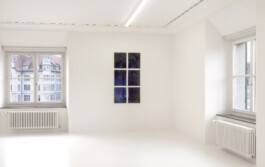
For her second solo exhibition at Livie Gallery, Esther Mathis (b. 1985) has recreated from memory windows of particular significance to her. Windows that she has spent many hours looking out through, and where she has watched the light come dancing in. These works evoke the remembered atmosphere of those window-lit spaces. Memory is often conceived of as a kind of glass through which we watch refractions of our previous selves as they fade into the distant past. And yet, it is hard to recall memories that specifically relate to light, and those we have are almost always related to windows we have known.
The form of most windows is dictated by their function: architecture and technology in dialogue with light. Before glass, when windows were fashioned out of paper or animal skins, or even marble, they have always been about how to invite light into an enclosed space. These days we spend more time inside our built-structures looking out than outside looking in. We wear our buildings like psychic skins, windows become our eyes on the world, but they also provide shelter, both physical and mental, from that world. A space to contemplate, to hear one’s thoughts thinking themselves. In English ‘window’ comes from the Old English eagduru meaning ‘eye-door’. Our windows are eyes, our eye-doors are windows.
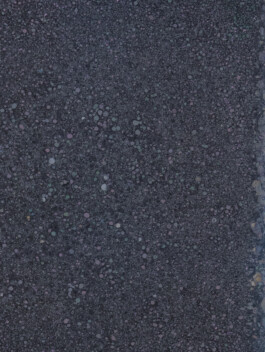
Mathis’s practice springs from what could be described as her alchemical imagination. The study of chemistry grew directly out of the practices of alchemy, yet chemistry is concerned with uncovering what we do not know, whereas alchemy works backwards in search of a secret knowledge that is already there. Mathis reverse engineers her way carefully through scientific phenomena to understand how to use them in her own artistic experiments. Pushing seemingly simple materials to their physical limits in order to create new effects that are part structured chance and part chemical romance.
But as with much of Mathis’s practice these works demonstrate a complex and poetic interplay between construction, material, process. Many of her works go in search of light and how to capture it, she is particularly fascinated with the temperatures of different colours of light and their effect on us, that we relax in warm light or concentrate in white/blue light. Many of these works also feature glass, Mathis is entranced by glass because of its peculiar physical properties. Neither really a solid or a liquid, glass is its own state of matter, combining the rigidity of crystals with the random molecular structure of a liquid. Like a memory it is never really fixed.
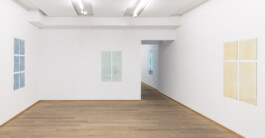
Each pane of glass in these works has been treated with a metal oxide, burned into the surface, and known as lustre. Familiar to many as the iridescent sheen seen in art nouveau glass, it is a technique that dates back to 9th century Mesopotamia, an age of great alchemists. Mathis worked with renowned glass fabricator Glas Mäder to apply powdered lustre to glass panes to achieve these ethereal hues. The lustre pigments allow the elusive light temperatures to be captured directly on the surface of the glass. Yet during this process it is impossible to really predict how they will look when they have been burned, in this sense the oven is also an author of the work, and the colours produced are like memories that get their mottled tone from the unpredictable heat of the present.
Mathis’s decision to let chance enter a body of work that is about memory is a gesture of alchemical anarchy in pursuit of aesthetic truth. We structure and constrain chance through memory with its many hues, seeing narrative purpose in the random, it is how we make sense of the world and ourselves in it, organising the chaos of experience into framed views, we are all castles with many windows.
Leila Peacock
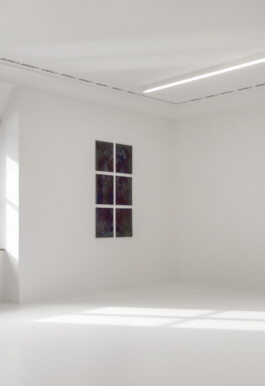
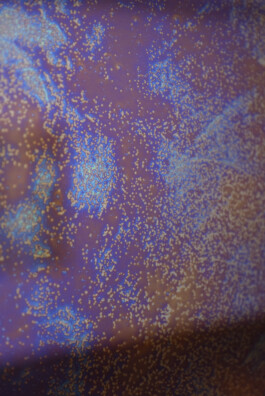
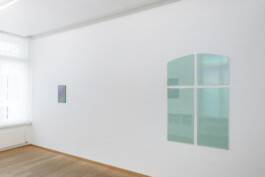
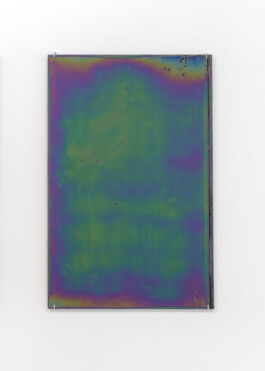
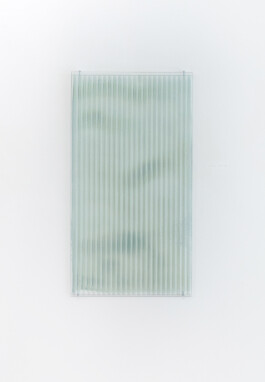

Installation views of Fenster, 2023 at Livie Gallery, Zürich and Helmhaus, Zürich
mineral pigment fluid and ink on glass
Various sizes
For her second solo exhibition at Livie Gallery, Esther Mathis (b. 1985) has recreated from memory windows of particular significance to her. Windows that she has spent many hours looking out through, and where she has watched the light come dancing in. These works evoke the remembered atmosphere of those window-lit spaces. Memory is often conceived of as a kind of glass through which we watch refractions of our previous selves as they fade into the distant past. And yet, it is hard to recall memories that specifically relate to light, and those we have are almost always related to windows we have known.
The form of most windows is dictated by their function: architecture and technology in dialogue with light. Before glass, when windows were fashioned out of paper or animal skins, or even marble, they have always been about how to invite light into an enclosed space. These days we spend more time inside our built-structures looking out than outside looking in. We wear our buildings like psychic skins, windows become our eyes on the world, but they also provide shelter, both physical and mental, from that world. A space to contemplate, to hear one’s thoughts thinking themselves. In English ‘window’ comes from the Old English eagduru meaning ‘eye-door’. Our windows are eyes, our eye-doors are windows.

Mathis’s practice springs from what could be described as her alchemical imagination. The study of chemistry grew directly out of the practices of alchemy, yet chemistry is concerned with uncovering what we do not know, whereas alchemy works backwards in search of a secret knowledge that is already there. Mathis reverse engineers her way carefully through scientific phenomena to understand how to use them in her own artistic experiments. Pushing seemingly simple materials to their physical limits in order to create new effects that are part structured chance and part chemical romance.
But as with much of Mathis’s practice these works demonstrate a complex and poetic interplay between construction, material, process. Many of her works go in search of light and how to capture it, she is particularly fascinated with the temperatures of different colours of light and their effect on us, that we relax in warm light or concentrate in white/blue light. Many of these works also feature glass, Mathis is entranced by glass because of its peculiar physical properties. Neither really a solid or a liquid, glass is its own state of matter, combining the rigidity of crystals with the random molecular structure of a liquid. Like a memory it is never really fixed.

Each pane of glass in these works has been treated with a metal oxide, burned into the surface, and known as lustre. Familiar to many as the iridescent sheen seen in art nouveau glass, it is a technique that dates back to 9th century Mesopotamia, an age of great alchemists. Mathis worked with renowned glass fabricator Glas Mäder to apply powdered lustre to glass panes to achieve these ethereal hues. The lustre pigments allow the elusive light temperatures to be captured directly on the surface of the glass. Yet during this process it is impossible to really predict how they will look when they have been burned, in this sense the oven is also an author of the work, and the colours produced are like memories that get their mottled tone from the unpredictable heat of the present.
Mathis’s decision to let chance enter a body of work that is about memory is a gesture of alchemical anarchy in pursuit of aesthetic truth. We structure and constrain chance through memory with its many hues, seeing narrative purpose in the random, it is how we make sense of the world and ourselves in it, organising the chaos of experience into framed views, we are all castles with many windows.
Leila Peacock




